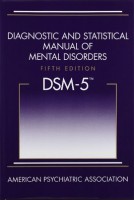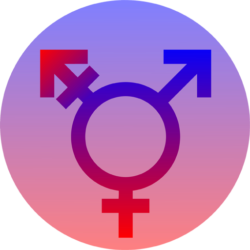DSM-5 (Diagnostic and Statistical Manual of Mental Disorders). Engelsk. Gældende.

| Titel | DSM-5 Diagnostic and Statistical Manual of Mental Disorders |
| Udgivet af | American Psychiatric Association (APA) |
| Udgivet | 22. maj 2013 |
| Sprog | Engelsk |
| Antal sider | 970 |
| ISBN-13 | 978-0-89042-554-1 |
American Psychiatric Association (APA) vedtog DSM-5 (Diagnostic and Statistical Manual of Mental Disorders) den 18. til 22. maj 2013 i San Francisco.
Diagnosefortegnelsen indeholder følgende transrelaterede diagnoser. Betegnelsen i parentes refererer til den tilsvarende diagnose i ICD-10.
Fetichistisk transvestisme (Transvestic Disordet) er placeret i et hovedafsnit betegnet “Paraphilic Disorders”, hvilket vil sige en tilstand, hvor en person bliver seksuelt ophidset og får seksuel tilfredsstillelse gennem fantasi om eller udøvelse af en ekstem og atypisk seksuel adfærd.
De øvrige transdiagnoser er placeret i et selvstændigt hovedafsnit betegnet “Gender Dysphoria” (kønsdysfori), hvilket vil sige et hovedafsnit, hvor det ikke kan opfattes som en sygdom, en lidelse eller en seksuel tilstand.
Indhold
Paraphilic Disorders (Hovedafsnit – start side 685)
Transvestic Disorder 302.3 (F65.1) (Side 702)
Gender Dysphoria (Hovedafsnit – start side 451)
Gender dysphoria in children 302.6 (F64.2) (Side 452)
Other specified gender dysphoria 302.6 (F64.8) (Side 452)
Unspecified Gender Dysphoria 302.6 (F64.9) (Side 452)
Gender dysphoria in adolescents and adults 302.85 (F64.1) (Side 452)
- Over a period of at least 6 months, recurrent and intense sexual arousal from crossdressing, as manifested by fantasies, urges, or behaviors.
- The fantasies, sexual urges, or behaviors cause clinically significant distress or impairment in social, occupational, or other important areas of functioning.
With fetishism: If sexually aroused by fabrics, materials, or garments.
With autogynephllia: If sexually aroused by thoughts or images of self as female.
Specify if:
In a controiled environment: This specifier is primarily applicable to individuals living in institutional or other settings where opportunities to cross-dress are restricted.
In full remission: There has been no distress or impairment in social, occupational, or other areas of functioning for at least 5 years while in an uncontrolled environment.
- A marked incongruence between one’s experienced/expressed gender and assigned gender, of at least 6 months’ duration, as manifested by at least six of the following (one of which must be Criterion A1):
- A strong desire to be of the other gender or an insistence that one is the other gender (or some alternative gender different from one’s assigned gender).
- In boys (assigned gender), a strong preference for cross-dressing or simulating female attire; or in girls (assigned gender), a strong preference for wearing only typical masculine clothing and a strong resistance to the wearing of typical feminine clothing.
- A strong preference for cross-gender roles in make-believe play or fantasy play.
- A strong preference for the toys, games, or activities stereotypically used or engaged in by the other gender.
- A strong preference for playmates of the other gender.
- In boys (assigned gender), a strong rejection of typically masculine toys, games, and activities and a strong avoidance of rough-and-tumble play; or in girls (assigned gender), a strong rejection of typically feminine toys, games, and activities.
- A strong dislike of one’s sexual anatomy.
- A strong desire for the primary and/or secondary sex characteristics that match one’s experienced gender.
- The condition is associated with clinically significant distress or impairment in social, school, or other important areas of functioning.
With a disorder of sex development (e.g., a congenital adrenogenital disorder such as 255.2 [E25.0] congenital adrenal hyperplasia or 259.50 [E34.50] androgen insensitivity syndrome).
Coding note: Code the disorder of sex development as well as gender dysphoria.
[Indhold] Other Specified Gender Dysphoria 302.6 (F64.8)
This category applies to presentations in which symptoms characteristic of gender dysphoria that cause clinically significant distress or impairment in social, occupational, or other important areas of functioning predominate but do not meet the full criteria for gender dysphoria. The other specified gender dysphoria category is used in situations in which the clinician chooses to communicate the specific reason that the presentation does not meet the criteria for gender dysphoria. This is done by recording “other specified gender dysphoria” followed by the specific reason (e.g., “brief gender dysphoria”).
An example of a presentation that can be specified using the “other specified” designation is the following:
The current disturbance meets symptom criteria for gender dysphoria, but the duration is iess than 6 months.
[Indhold] Unspecified Gender Dysphoria 302.6 (F64.9)
This category applies to presentations in which symptoms characteristic of gender dysphoria that cause clinically significant distress or impairment in social, occupational, or other important areas of functioning predominate but do not meet the full criteria for gender dysphoria. The unspecified gender dysphoria category is used in situations in which the clinician chooses not to specify the reason that the criteria are not met for gender dysphoria, and includes presentations in which there is insufficient information to make a more specific diagnosis.
- A marked incongruence between one’s experienced/expressed gender and assigned gender, of at least 6 months’ duration, as manifested by at least two of the following:
- A marked incongruence between one’s experienced/expressed gender and primary and/or secondary sex characteristics (or in young adolescents, the anticipated secondary sex characteristics).
- A strong desire to be rid of one’s primary and/or secondary sex characteristics because of a marked incongruence with one’s experienced/expressed gender (or in young adolescents, a desire to prevent the development of the anticipated secondary sex characteristics).
- A strong desire for the primary and/or secondary sex characteristics of the other gender.
- A strong desire to be of the other gender (or some alternative gender different from one’s assigned gender).
- A strong desire to be treated as the other gender (or some alternative gender different from one’s assigned gender).
- A strong conviction that one has the typical feelings and reactions of the other gender (or some alternative gender different from one’s assigned gender).
- The condition is associated with clinically significant distress or impairment in social, occupationali^or other important areas of functioning.
With a disorder of sex development (e.g., a congenital adrenogenital disorder such as 255.2 [E25.0] congenital adrenal hyperplasia or 259.50 [E34.50] androgen insensitivity syndrome).
Coding note: Code the disorder of sex development as well as gender dysphoria.
Specify if:
Posttransition: The individual has transitioned to full-time living in the desired gender (with or without legalization of gender change) and has undergone (or is preparing to have) at least one cross-sex medical procedure or treatment regimen-namely, regular cross-sex hormone treatment or gender reassignment surgery confirming the desired gender (e.g., penectomy, vaginoplasty in a natal male; mastectomy or phalloplasty in a natal female).
* * *
Omtale af DSM-5 hos APA.
DSM Library.
American Psychiatric Association.
Omtale af DSM-5 hos Amazon, hvor den også kan købes i bogformat.
